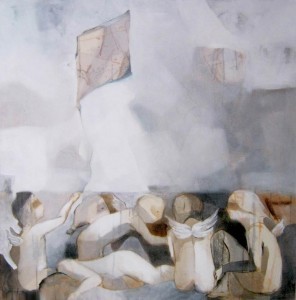Syria reborn on Canvas

Jean Boland
Two years after the uprising in Syria began, a generation of young artists finds themselves recreating their homeland in their imaginations and on canvas, as they struggle to make sense of a reality that is at odds with their creative and aesthetic values.
Forgotten walls, memories, photographs and writings abandoned in a hurry, a record of transitory moments; for artist Abdel Karim Majdalbeik, these canvases which precede the crisis in Syria contain the everyday stories and tiny details he used to try to recapture the spirit of the Syrian street. Sometimes the subject matter is public, sometimes private, but always Majdalbeik’s works convey a visual text that engages with the space while invoking the sensitivity of the different materials he uses in his work. Combining scenes from a past time with almost childlike drawings, Majdalbeik employs mixed media and various adhesives to create a narrative description of a specific moment.

A year the start of the revolution, we can see the following among his canvases: One piece includes a torn, scorched piece of cloth and the remains of other destroyed objects, as if an army had passed and stamped its brutality on the canvas; fragments of childhood memories rendered in the strange colours of death; jeans; a lot of weapons; knives squabbling over the remains of an old robe or a refugee’s tent–even small bird traps.
Abdel Karim says these orange, white and black traps are at once threatening and enticing, luring in the viewer just as the trap ensnares birds.
Artist Rim Yessouf also deals with the violence in Syria in her work, touching on the challenges, the desire to flee and the dream of a more human and daring future.
According to Yessouf, an artist influences, but is also influenced by his or her surroundings and experiences. Every artist does personal research, but usually the creative process moves from the personal to the public in its effort to address social realities.
Yessouf creates a harmony in her works between the empty spaces and the more dynamic elements of her composition, coming together to form a comprehensive whole that transcends its contradictory parts. This balance elevates the work above the sharp debates raging within the visual text.

Yessouf’s palate tends towards a monochromatic, ghostly grey, but one cannot overlook the importance of her use of the colour white. Among all the promiscuous colours, white represents purity, especially in times of war and destruction, when vividness becomes redundant.
For Yessouf, white has an”inimitable simplicity”, it is “a small child who plays among us and reflects our impressions in all the rich shades of shadow.”
White is also “a kite made from the page of our notebook on which we wrote our dreams and wishes. White is my friend and my enemy, as it must be and as I willed it,” she says.
Yessouf also compared white to a baby, a recurring symbol in her most important series since the crisis started.
“White is like a baby on whom we leave our mark, our violence and our peace. It is our future,” she says.
Rabih Kiwan, another Syrian artist, features human subjects prominently in his work, exploring their concerns, both routine and existential.
Before the events in Syria, Kiwan’s subjects were calm, wrapped up in day-to-day worries. However, it was not long before his canvases, like Syria itself, became the site of violent conflicts. Now we see children in funeral shrouds suspended between the folds and the blank expanse of the canvas. People’s faces traced with death, their features set in expressions of cruel silence and clear challenge. Silent children tell stories of their maiming and deaths, creating, in one way or another, a visual text that challenges the viewer’s silence and transfers to him or her a burden so unbearable one wishes only to be free of it.

Kiwan’s women are tormented and his men mangled, wracked by unimaginable pain, pushing the viewer to read between the lines to see a shocking and unvarnished reality.
At first glance, tank treads are merely a pattern, but one soon feels the weight of the vehicle crushing one’s soul. A piece of coloured cloth pasted above the tank catches the viewer’s eye. Is it an attempt to lighten the material or a dash of bitter sarcasm, a way of having some fun with the tank as the children of Homs did when they hung a hammock from the gun of a destroyed tank? Looking at Kiwan’s canvases, one finds many answers awaiting only the right question.
There are many examples of Syrian artists whose work has clearly been affected by the violence sweeping their country, while others continue to work as they did before the crisis.
The most controversial question among young Syrian artists has to do with what will happen next for a generation that has seen its dreams dashed and been forced to recreate their memories of bloodshed, destruction and the horrors of war.
